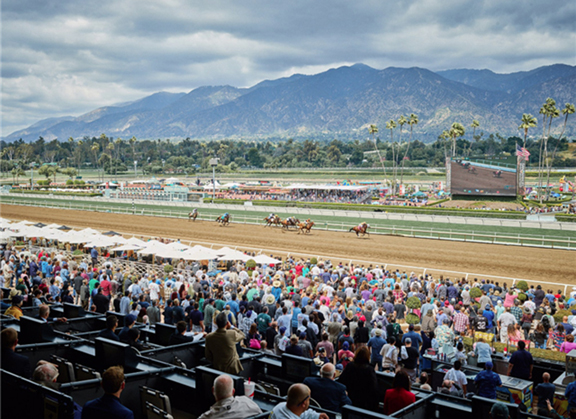The following is an abridged version of the Thoroughbred Idea Foundation's #FreeDataFriday entry for this week. The full version can be read at this link.
Here is a simple question: How much revenue does a horse race produce for the horsemen running horses in that race?
The answer is incredibly complex, and in many jurisdictions, almost impossible to discern.
A publication from the Thoroughbred Owners of California in 2016 offers a glimpse into an answer, at least for races run in that state. While these numbers are likely to have changed since their last publishing, they offer some interesting insight to the revenue distribution scheme.
Let's focus on a bet made on a race at Santa Anita in 2016. In the simplest presentation possible, here are the details of the percentages that went from the wagering dollar to purses from a customer betting on that race:
From Santa Anita – 9.46%
From a California OTB – 6.76%
From an ADW account in California – 5.35%
From any bet on the race made outside of California – 3.40%
There are some intricacies in the California model which we have intentionally excluded for the sake of clarity.
In addition, purses in California received 2.79% when a California customer bets via ADW on races out of California – be it Belmont, Turfway, Will Rogers Downs or any other track.
Instead of an equitable split, where a dollar bet on a Santa Anita race yields the purse account the same no matter where that dollar is bet, the jumble outlined above serves as the model.
Of course, for many tracks, money bet off-track represents the super majority of handle. This is problematic.
A quick glance at the total handle figures from these different sources confirms the obvious: on-track and OTB handle is down, ADW handle is up–but the shift is hardly even. In 2018, California handled a combined $421 million less from on-track and California OTB sources compared to 2010. The increase in ADW handle of $161 million from 2018 over 2010 does not erase the difference, which is compounded by the reality that this increase is in the least valuable source for the purse account.
So if purses aren't getting a sustainable share of revenue, who is?
This dialogue could get increasingly complex and dabble into source market fees, geolocating and what not. But for today's purposes, we will keep it simple. Think of it this way – on-track and OTB bets are highly-regulated wagering sites, but the majority of play has shifted to lightly-regulated ADWs. In some cases, the biggest ADWs can end up retaining nearly half of wagering revenue, serving as technological bet-processors, while purse accounts are left to make due with roughly a quarter.
ADWs are facilitating more and more bets, an obvious technological evolution, but are they doing so at the expense of the sustainability of the very races on which they offer wagering?
This model is madness.
Make no mistake. You cannot blame the ADWs for this model. The horsemen have, in some capacity, approved this status quo.
What didn't seem to matter as much when ADW handle was in the low single-digit percentages now matters far more when it is approaching half of all betting.
Calls for change are NOT new. In 2007 at the Jockey Club Round Table, then CEO of Churchill Downs Incorporated (Robert Evans) and the Chairman of the National HBPA (Joe Santanna) echoed each other, from very different perspectives, about the need to develop a new model.
Evans: “We're simply trying to deal with the fact that the original business model under which the industry's ADW business was created is terribly flawed…but, facts are facts. It's not working.”
Santanna: “A critical review of what represents a fair portion from the takeout for purses is absolutely necessary. We may have to redesign the model–move away from host fees, move away from source market fees–to fuel the proper amount of money necessary to make purses correct.”
So what's going to change now? What will make this time any different?
The one constant we have experienced over the last 15 years is a decline in wagering handle, particularly when accounting for inflation. Meanwhile, the overall cost of wagering has actually increased. This adds to an already sub-optimal situation.
So how does racing generate more for purses? Raising the cost of betting–the takeout–is not the answer.
An analysis of the California racing industry was conducted by the Giannini Foundation of Agricultural Economics at the University of California in 1991. Keep in mind that at the time this study was published, nationwide handle, adjusted for inflation, was roughly $16 billion, or about 31% higher than 2019. Demand was stronger. If anything, the need to be more aggressive in improving the pricing of racing wagering is greater.
“Perhaps most notable is the finding that total pari-mutuel revenues are very responsive to changes in the effective takeout rate. In economic terms, the demand for wagering is found to be highly elastic with respect to the 'price' of a typical wager. This result indicates that pari-mutuel revenues can be enhanced by reducing the current effective takeout rate.”
It truly is time to seek common ground.
There are two clear issues: the revenue distribution model which determines how purses get funded is in need of monumental renovation, while concurrently, appropriate takeout rates should be implemented which meet customer demand.
If we have collectively endured decades of this mismanaged situation, which has led us to this sub-optimal state, where is the harm in bringing everyone to the table and starting over, trying to build a better future for the entire industry?
Let's do it.
Not a subscriber? Click here to sign up for the daily PDF or alerts.






